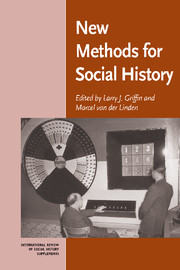Book contents
- Frontmatter
- Contents
- NOTES ON CONTRIBUTORS
- Introduction
- Temporally Recursive Regression and Social Historical Inquiry: An Example of Cross-Movement Militancy Spillover
- Using Event History Analysis in Historical Research: With Illustrations from a Study of the Passage of Women's Protective Legislation
- Incorporating Space into Social Histories: How Spatial Processes Operate and How We Observe Them
- Narrative as Data: Linguistic and Statistical Tools for the Quantitative Study of Historical Events
- The Logic of Qualitative Comparative Analysis
- Historical Social Network Analysis
- Historical Inference and Event-Structure Analysis
The Logic of Qualitative Comparative Analysis
Published online by Cambridge University Press: 04 August 2010
- Frontmatter
- Contents
- NOTES ON CONTRIBUTORS
- Introduction
- Temporally Recursive Regression and Social Historical Inquiry: An Example of Cross-Movement Militancy Spillover
- Using Event History Analysis in Historical Research: With Illustrations from a Study of the Passage of Women's Protective Legislation
- Incorporating Space into Social Histories: How Spatial Processes Operate and How We Observe Them
- Narrative as Data: Linguistic and Statistical Tools for the Quantitative Study of Historical Events
- The Logic of Qualitative Comparative Analysis
- Historical Social Network Analysis
- Historical Inference and Event-Structure Analysis
Summary
INTRODUCTION
Social scientists often face a fundamental dilemma when they conduct social research. On the one hand, they may emphasize the complexity of social phenomena - a common strategy in ethnographic, historical and macrosocial research – and offer in-depth case studies sensitive to the specificity of the things they study. On the other hand, they may make broad, homogenizing assumptions about cases, and document generalities – patterns that hold across many instances. Research strategies that focus on complexity are often labeled “qualitative”, “case-oriented”, “small-N”, or “intensive”. Those that focus on generality are often labeled “quantitative”, “variable-oriented”, “large-N”, or “extensive”. While the contrasts between these two types of social research are substantial, it is easy to exaggerate their differences and to caricature the two approaches, for example, portraying quantitative work on general patterns as scientific but sterile and oppressive, and qualitative research on small Ns as rich and emancipatory but journalistic. It is important to avoid these caricatures because the contrasts between these two general approaches provide important leads both for finding a middle path between them and for resolving basic methodological issues in social science.
Social scientists who study cases in an in-depth manner often see empirical generalizations simply as a means to another end – the interpretive understanding of cases. In this view, a fundamental goal of social science is to interpret significant features of the social world and thereby advance our collective understanding of how existing social arrangements came about and why we live the way we do. The rough general patterns that social scientists may be able to identify simply aid the understanding of specific cases; they are not viewed as predictive.
- Type
- Chapter
- Information
- New Methods for Social History , pp. 105 - 124Publisher: Cambridge University PressPrint publication year: 1999



